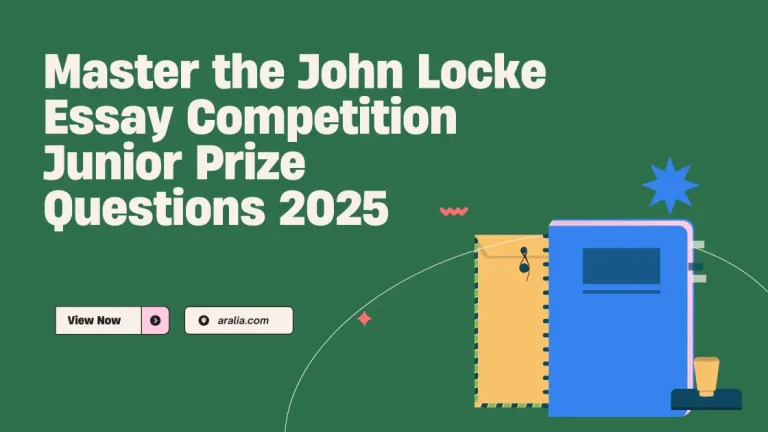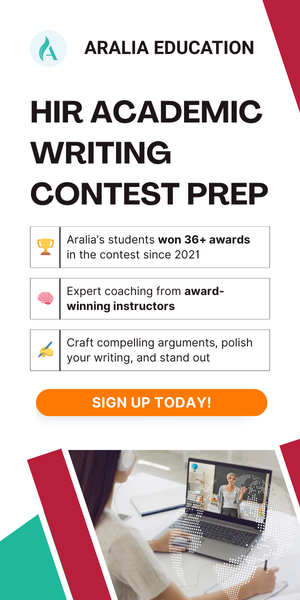1. What is the New York Times Summer Reading Contest?
The New York Times Summer Reading Contest, hosted by the New York Times, invites teenagers all around the world to choose something in The Times that has piqued their interest and explain why through writing or video for a chance to be published on the New York Times website. The goal of the competition is to open up students’ minds to the world and their place in it while they practice writing or presenting for an audience.
Unlock Your Writing Potential: Students in Our Writing Competition Prep Class are 4x More Likely to Secure First Place
Join successful Aralia students who have secured admission to their dream schools. Our personalized approach to education, coupled with expert guidance, ensures that students are equipped with tools and support needed to stand out in the admissions process.
2. Who can participate in the contest?
Teenagers from 13 to 19 years old anywhere in the world are invited, whether in middle school, high school, or recent graduates from high school who haven’t yet started college.
3. What’s the contest timeline and structure?
For 2024, the contest dates are June 7 to Aug 16, 2024. To celebrate the 15-year anniversary of the competition, this year, the New York Times has a bit of a different submission process.
Every Friday for 10 weeks beginning on June 7, the New York Times publishes a post asking the question, “What got your attention in The Times this week?” Then, students have until the following Friday at 9 a.m. Eastern time to submit a short written response — or make a video of up to 90 seconds long. Every week until August 9, they will post the same question and open the submission portal for that week. Students can enter every week if they wish, but they can only submit once each week. The last question will be posted on August 9 and open until 9 a.m. on Aug. 16.
When do I know about the result?
Winners will be chosen every week on Tuesday during the contest, starting June 25, winners will be published in a separate post on the website.
4. New York Times Summer Reading Contest Schedule
The contest runs from June 9 to Aug. 18.
Week | Start Date | Submission Deadline (9 am ET) |
1 | June 7 | June 14 |
2 | June 14 | June 21 |
3 | June 21 | June 28 |
4 | June 28 | July 5 |
5 | July 5 | July 12 |
6 | July 12 | July 19 |
7 | July 19 | July 26 |
8 | July 26 | August 2 |
9 | August 2 | August 9 |
10 | August 9 | August 16 |
5. How do I submit to the competition?
Students can find the link to submit to the competition at the top of this page or on their homepage. For this competition, students can submit a response as a 250-word essay OR a 90-second video.
For written responses, students ages 13 to 19 in the United States and Britain — and ages 16 to 19 elsewhere in the world — can submit by posting a comment on the post itself. However, if you’re 13 to 15 anywhere in the world besides the United States and Britain, a teacher, parent, or guardian of a student or child should submit an entry on the student’s behalf using the form embedded at the bottom of each week’s post.
For video responses, all students should use the form at the bottom of each week’s post to submit their video. Students ages 13 to 19 in the United States and Britain—and ages 16 to 19 elsewhere in the world—can submit their own entries. Students age 13 to 15 anywhere else in the world must have a parent, teacher, or guardian submit on their behalf.
6. What topic can I write about?
There is no limit to the topics that students can write about, as long as the article was published in the print paper or on NYTimes.com in 2024, including articles, Op-Eds, videos, graphics, photos, and podcasts. Throughout the years, we have seen students writing articles about Himalayan glacier loss, Minions taking over the world, to steak and cattle ranchers.
7. What makes a great submission to the contest?
First, a great writing submission must follow the contest guidelines. Submissions should not exceed 1,500 characters, or about 250 words. The word count also includes the complete URL or headline of the Times piece you have chosen, such as “The Joys and Challenges of Caring for Terrance the Octopus” or https://www.nytimes.com/2024/04/11/us/tiktok-octopus-pet-oklahoma.html.
Video submissions should explain the Times piece you chose and why. Your video should be vertical and 90 seconds or fewer. Don’t forget to say or show the headline of the Times piece you are discussing. Your video may not use any images, video clips, music, or sound effects other than those that appear in the Times piece you are discussing or what you create yourself. Second, please ensure your video sound is clear and background noise-free. The video shouldn’t include anyone else besides you.
Follow the resources provided by the New York Times
- Writing Resources and Lesson Plans on independent reading and writing.
- Student Mentors: “Writing Rich Reading Responses: Participating in Our Summer Contest” showcases student-written mentor texts as examples for students. In addition, winning student entries and reflections are always available on the website.
- Webinars: This free webinar from 2020. is also available if students want to learn more about the contest.
8. How to submit a response that stands out above the rest?
There are 4 key components that make up an exceptional contest response, after you have chosen a topic that has piqued your interest. The first component is to make sure the piece you’ve picked has some personal connection to you. The deeper the connection, the more you can passionately discuss it in your response; however, keep it short due to the word count restrictions. This is where you’ll have to bring out your best writing abilities to succinctly convey your feelings and thoughts properly to the judges since people, by nature, can go on and on about what they are passionate about. An easy way to build a personal connection to the news articles is by interpreting and analyzing your thoughts as you read the title and its texts. Consider things such as knowledge or associations with the topic before reading the full article, how it is associated with your past or present, or perhaps connected to someone you know so that you can bring your own personal identity in the response.
The second component is to express your thoughts and feelings as you read the news piece. For example, thoughts such as did this article/piece give you a sense of nostalgia, or perhaps it moved you to tears? Bring the judges on the journey with you as you describe your emotions and thoughts so they can understand from your point of view. Being as descriptive as you possibly can would help so that the judges can understand your thought process. For example, if you felt sad due to a certain quote or an event that the article was written about, and it reminded you of a certain situation that you were involved in yourself or perhaps someone close to you, you could describe that scene in detail as if the judges were there themselves. You could also describe how you are curious about the article and how it made you want to do further research or if any questions were raised in your head as you read the text piece; addressing the piece’s strengths and weaknesses also helps provide evidence that you had carefully analyzed it and critically thought about it.
The third component is to make sure to reference a specific detail within the piece. To keep you from trailing away from the actual piece, it is best to ground your thoughts and words by referencing a particular detail that had made the biggest impact on you. There are plenty of ways to approach this component. From the second component, you can choose a section, image, or quote that really spoke to you and use that to support the message you want to get across. You can also pick something that has provided you with new information; for example, Hannah Li, one of the previous winners, chose to write an article “to Beyoncé or not to Beyoncé: The challenges of Confirming the Birth of Her Twins,” and wrote about the process and difficulty that Maya Salam had to go through to get solid evidence of the twins’ birth. She particularly spoke about how Maya didn’t settle for “rumors” or “fake news” and kept persisting to confirm concrete evidence of the twins. She leveraged all of her connections and still pulled up empty-handed. The contestant then described her thoughts and feelings about how it opened her eyes to how dedicated the NY Times is to the truth rather than rumors just to be the first to drop any type of publication about Queen B’s pregnancy, even if it is just false news.
The final component is making sure you write in your own style. The response is for a contest; however, it is crucial to write it in a way that the judges are able to get a sense of who you are and that you are truly enjoying the piece in the response. This is what sets writing a response in this contest apart from just writing out of obligation or being forced to because it takes time, effort, and a thought-out process– it cannot be quickly put together in a matter of minutes. As an easy way to express yourself freely, you can think of how you would share the article/news piece with a friend or family. You’d never do it formally, so you should write similarly. If you are usually funny when talking amongst your friends and family, be funny; or, if you are witty, use puns or slang and incorporate that into the response– but of course, be mindful that it is a contest. You are writing for the general public to see. Think about your personality and which part of you want the judges to see, and speak to them through your response. Think outside the box and let your thoughts flow since you can always edit it before submitting it in the final draft.
9. How is my work evaluated?
The judges use a rubric that is scored from 1-4, one being the lowest, and it is based on how well the contestant incorporated the four categories: Personal Connection, Critical Thinking, References to the Times Source Material, and Voice and Style into their response. There is also an additional category for staying within the guidelines of the contest. More information about the rubric can be found here.
10. New York Times Summer Reading Contest Past Winners
in 2018, Lisa Mishra won the contest with her response to an article titled “Everyone Has an Accent,” and in this response, she directly quotes from the article itself, “No one Speaks without an accent.” From this quote, she goes on to take the judges on a journey as to how this line impacted her greatly. From her getting made fun of because of her Indian accent as a child to how it brought her to tears and drove her into a hole to proudly wearing her family’s Indian accent as part of her family and culture.
In 2019, Cody Busch-Weiss, wrote his response to the article “The Em Dash Divides,” and incorporated his more fun and free style of writing by playing with the punctuation, as the article is about the em dash. In his response, he shares how versatile punctuation is and that it can be used to replace all of the other punctuation’s functionality. He proceeds to overuse it throughout his response to add to his playful personality and points out that the article is about how punctuation is used to help the text and not steal the show.
Join Aralia's NY Times Summer Reading Preparation Class

This class is offered in the spring every year. Students from 13 to 18 years old wanting to learn how to shape their written English into effective and publishable creative pieces will find this particular Writing Competition course very exciting. The class will be shown a range of tools to learn the nuances of controlled, purposeful writing, including: figurative language, effective structuring and specific forms that they will apply to their own pieces.










